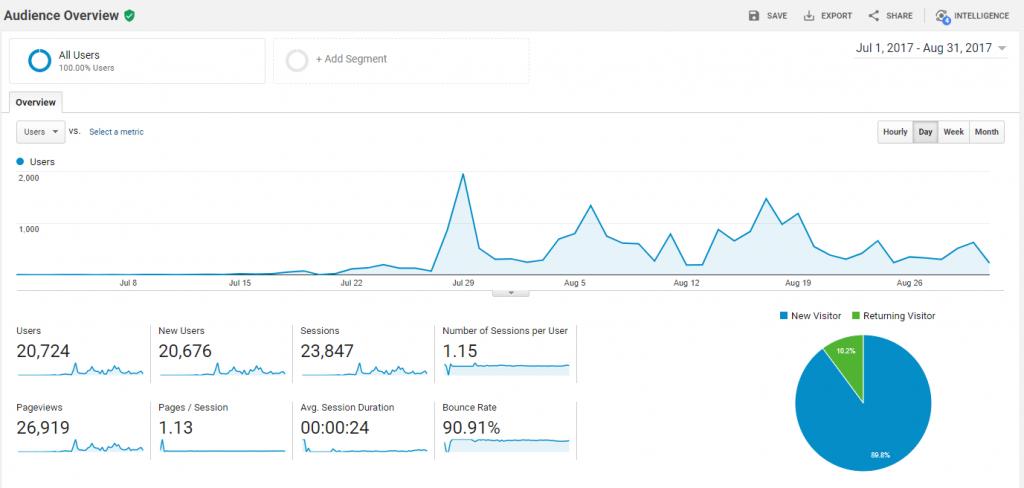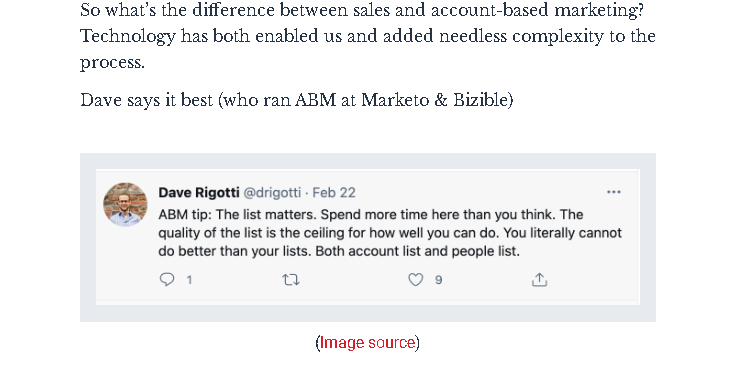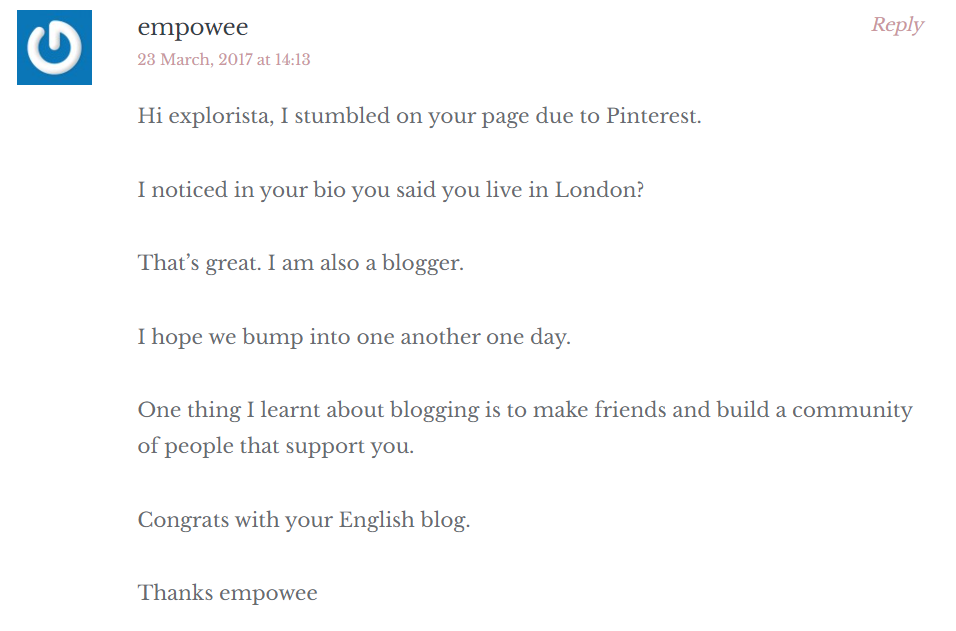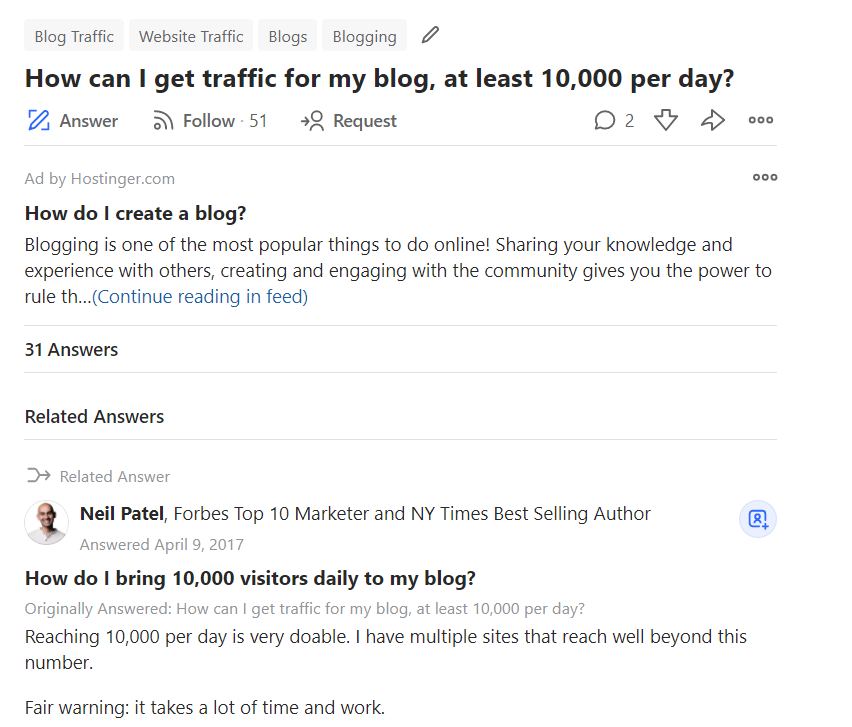The exact volume you can achieve depends on initial conditions and your strategy. In this post, we’ll discuss techniques that’ll be useful for aspiring bloggers without any special background in the niche or thousands of followers on social media.
1. Promote Content on Social Media
Sharing content on social media is a great way to boost traffic fast, and you may even get visitors the first day with paid social. However, posts only show up well on social networks for a day or less, and social traffic wanes if not supported by daily efforts.
Peep Laja of ConversionXL sets a great example of how sharing content across social platforms can bring traffic to your blog fast. Here’s what he did to get there:
- Peep Laja shared his posts on Facebook, Twitter, Reddit, StumbleUpon, and Hacker News.
- As the content was high quality, readers voted for it, so posts kept spreading.
- Peep added social share buttons to all articles and asked readers to subscribe to the newsletter or follow him on social media.
Another example of a successful social strategy may be found on Catherine Oneissy’s blog. Catherine boosted blog traffic by creating pins for each of her posts on Pinterest, received 5,000 pageviews in just two weeks, and reached the 21,000 pageviews mark in the second month.

However, getting stuck with such a variety of social media platforms is a common mistake, which can dampen the whole process. Henri Junttila recommends focusing on one platform and scaling from there. If you still want to use different networks, automate your marketing with social media management tools.
2. Post SEO-Friendly Articles
Search engines can be a source of traffic coming to your blog for years, but it may take months before you start getting visitors. To make that happen, you need to write useful SEO-friendly posts and update them regularly.
The good thing about search traffic is that it is easily projected for a specific query. Tools like Google Keyword Planner allow you to study the amount of queries and get an estimate of traffic volume for an article if it makes it to the top search results. However, you need to understand that SEO traffic won’t get you tons of traffic the first month and is a long term solution.
Peep Laja of ConversionXL focused on writing long and thorough posts with plenty of links to sources and great pictures. To enhance readability, Peep uses font size 16, equivalent to the way text looks in paper books, line height 24p, Georgia font, and a new paragraph every 4 to 5 lines.
On the same note, Sujan Patel, entrepreneur and digital marketing strategist, believes that you should write 1,000 words per post at minimum and increase word count to the extent possible. For example, the first post in the SERP contains on average 1,890 words, so keep it up!
3. Do Keyword Research
As a continuation of the previous point, SEO is inconceivable without proper keyword research. Keywords are search terms that people use when looking for a topic on search engines, and they can help site owners with marketing and ranking higher in the SERP.
Essentially, there are short-form and long-form keywords. Short-form keywords usually contain three or less words and have high search volumes, while long-form keywords include four or more words and have low search volumes. It’s hard to compete for short-form keywords especially for those who are starting a blog, so at first you may want to focus on longer phrases. They can bring more targeted traffic and convert at better rates, as 70% of search queries are related to long-tail keywords. Moreover, Google may treat keyword variations as equal, so ranking for one long-form keyword might also make you rank for its variations.
Once you research the keywords your audience uses when searching on the internet, it’s important to optimize your content. Here are a few ideas of how to do that:
- Title tag. Titles are displayed in the search results and can impact your click-through rates and ranking, so be sure to use one or two keywords within this space as long as the title looks natural.
- Meta description. This is what search engines show to users in the SERP right below your post title. Briefly describe your page content and add a couple of keywords.
- URL. URLs are also a ranking factor, so they give you another opportunity to add relevant keywords that’ll help both search engines and users understand what your page is about.
- Header tags. They also impact your position in the SERP, so you can use short-tail or long-tail keywords in them. While H1 tag carries the most weight in terms of ranking and should be built around your main keyword, H2 and H3 tags can fit long-tail keywords.
- On-page content. Try to add both short-form and long-form keywords into your body text. At Travelpayouts, we stick to keyword density up to 2% to avoid looking spammy to search engines.
- Image name. A terrific opportunity to get your image ranked on search engines is by using target keywords in its name. You can also leverage captions and alt attributes.
4. Optimize Your Website for Search Engines
Proper on-page SEO optimization will help Google understand what your page is about and drive to your target audience. It goes beyond keyword research and includes:
- Getting HTTPS protocol to enhance security
- Creating a sitemap for your site
- Fixing broken links
- Improving page speed
- Avoiding duplicate content
- Using optimized visuals
- Making your site mobile-friendly
- Creating various types of content
- Adding social share buttons
- Using SEO plugins
- Building internal links
In addition to on-page SEO, off-page optimization is a necessary step towards online success. In our guide, you’ll learn the complete process of off-page search engine optimization.
5. Run Ads
Ads are an efficient way to increase traffic to your blog fast. The downfall is that advertising can be expensive, and for aspiring bloggers, it is only justified if it pays off. For that, you need to know your spend and compare it against revenue.
You can make good use of paid traffic by sending it to your best posts to improve page behavioral factors, such as average reading time, engagement rate, etc. This will show Google that your post is useful for the audience so it may get higher in the SERP.
One of the most popular advertising platforms is Google Ads. To start off, you need to create an account, set up a campaign and determine the budget. You can find a step-by-step instruction on how to wield it in our special post.
Another powerful network to advertise on is Facebook. Today, it accounts for over 83% of social ad spending, and its algorithm is unparalleled in terms of reach. For instance, you can find your best clients, create custom audiences, and derive insights from built-in analytic tools. Learn how to use Facebook Ads in our guide.
6. Guest Posts
Guest posting is an amazing way to kill two birds with one stone as it allows you to get a backlink and network at the same time. In addition, guest posts bring quality traffic, help grow brand awareness, get more subscribers and even help you become a better writer.
Henri Junttila, blogger and publisher on Amazon, finds that guest blogging brought more traction to his blog than any other technique. First, it’s important to fill in your blog with some quality materials before submitting guest posts to other sites. Then, look for a couple of small blogs in your niche and pitch them three relevant headlines that’ll engross readers.
In the same vein, Neil Patel is very much of the opinion that guest posting can help grow your audience. One way to do that is by pitching your idea to online magazine editors with a strong online presence, such as Entrepreneur, Forbes, or any other site just as popular. Take advantage of their targeted audience and establish authority in the niche at the same time. Pick topics that’ll be engaging for your readers and pitch them to magazines’ editors.
7. Build Online Partnerships
Networking can be beneficial in many ways. First, it allows you to reach wider audiences and establish authority. Second, online partnerships help drive referral traffic which often converts at high rates, as referred visitors will trust you. Third, networking makes it possible to connect with like-minded people and create joint projects.
Here are a few ideas how to reach outside the confines of your blog:
- Start by guest blogging. This will get you backlinks and help get your name out there. You can also do guest post swap and cross-promote each other’s blogs.
- Join mastermind groups. Masterminds involve peer-to-peer tutoring where group members help each other achieve the objectives. Many reputed bloggers like Pat Flynn or John Lee grew their blog’s readership with mastermind groups.
- Do blogger outreach. With dedicated tools, you can easily find influencers in the niche and contact them with an offer.
For instance, Sujan Patel would mention influencers and send them an email letting them know they’ve been featured. It is a great icebreaker that helps rev up bloggers’ visibility and build relationships in the niche.
Here is an example from Milou, travel blogger and the voice behind the Explorista blog. What brought her success was developing a networking strategy for each social media platform, namely:
- Twitter: sharing two posts from other writers daily to form a blogger community.
- Facebook: sharing another blogger’s post every day and her own article once it’s written.
- Instagram: engaging with other people’s content super actively.
- Pinterest: pinning posts of other marketers daily and creating pins for each of her posts
- Snapchat: sharing content whenever there is something to share.
With all that, Milou managed to establish relationships with other bloggers in the niche, earn backlinks and drive more traffic to her blog.
8. Add Sign Up Forms
Email traffic is the most consistent type of traffic after search engines. The best way to collect emails is by creating a beautiful sign-up form on your blog that will encourage visitors to subscribe to your mailing list. For example, popups generated 85% of all email subscriptions for Peep Laja of ConversionXL.
To make your form attractive, be sure to minimize the number of fields in it and describe the newsletter content so that users know what they subscribe to. Here is a concise example of a sign-up form from The Smart Passive Income Blog:

9. Create a Variety of Content Types
Marketers often face hurdles when trying to come up with new content ideas. Sometimes, it’s meaningless to throw in repetitive blog articles, and the best option would be to diversify content. This will give your audience a fresh perspective, increase shares and engagement rates and help get more backlinks. For example, you may mix it up with:
- Infographics
- Presentations and slides
- Videos
- Webinars
- Podcasts
In our blog, you can find 19 types of content that every blog needs, which will allow you to reach out to a wider audience and improve your blog figures.
10. Reference Well-Known Bloggers
Mentioning influencers in your content can boost its relevance and credibility, and give you a reason to reach out and increase shares. It’s important to not go after only big shots but rather quote those who have something good to say, regardless of their number of followers.
Peep Laja of ConversionXL believes that entrepreneurs and bloggers have big egos, so you can take advantage of that and mention them in your content to attract their attention. For instance, he links to brands and influencers in his posts and lets them know over email or Twitter.
Another approach Peep takes is to send a draft of his content to an influencer to ask for their thoughts and get a unique quote.

11. Comment on Other Blogs
Another way to get a blog noticed is by leaving comments on other bloggers’ posts. It gives you an opportunity to leave a backlink to your blog and, therefore, drive targeted traffic. Commenting also helps build relationships in the niche, as you boost the engagement for influencers who may return the favor and comment on some of your posts. You’re likely to get noticed by more bloggers and get your name out there.
So, how do you write a comment that gets noticed?
- Greet the author. Don’t be afraid to say hi and greet them by name.
- Compliment the post. Acknowledge the things that you liked in the post, but try to not praise the author too much. Focus on the post itself to avoid looking creepy.
- Add value. Think of ways to enhance the post, for example, ask thoughtful questions to engage the author or readers, share personal thoughts, or express a different perspective.
In the example below, the comment compliments the author and adds value to the post by sharing a link to more useful information on the topic.

You can also use the comment section to build relationships and network, as in the following example.

12. Answer Questions on Forums
While time-consuming, answering questions on forums can help drive traffic tremendously, get your name out there, and position yourself as an expert. What’s more, by combing through forums, you’ll learn more about your audience and what kind of solutions they’re looking for, which, in turn, may enhance your offer. You can share short answers and send users to your post for more information, or write in-depth, as Neil Patel does on Quora.

Matthew Woodward provides a successful example of such an approach. With dedicated tools like Boardreader and Omgili, he’d find forums with relevant questions, answer them and leave a backlink to his blog post with more information on the topic. Matthew spent an hour daily answering questions and four hours each time he published a new post. This strategy alone brought him over 2,000 unique visitors in 30 days.
How to Drive Traffic to Your Blog Fast
The question of how to get traffic to your blog is often the hardest part for aspiring webmasters. While there is no silver bullet, the strategies outlined above will allow you to attract the first visitors fast and pave the way for successful growth in the long term. Choose a few strategies to start with and gauge their efficacy to make sure your plan doesn’t get derailed if some of them don’t work for you.





